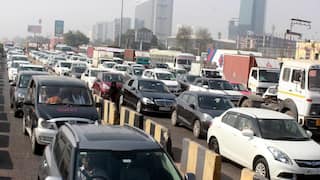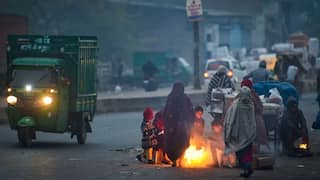Climate Change, Pollution Likely To Fuel More Sikkim-Like Disasters, Warn Experts
Scientists have warned that climate change and other related issues can lead to more Sikkim-like disasters in the near future.

Rising temperatures, glacial melt, heavy rainfall... The multiplier effect of climate change combined with untrammelled construction and pollution to wreak havoc in Sikkim, say scientists, warning that more such disasters in the Himalayas could be in the offing with the rise in the number of glacial lakes. As Sikkim picks up the pieces following flash floods that saw many thousands being displaced, major infrastructure projects destroyed and scores of people killed earlier this month, experts said other Himalayan states, including Himachal Pradesh, Arunachal Pradesh and Jammu and Kashmir, are susceptible to similar glacial lake outburst floods (GLOF).
A GLOF is a catastrophic deluge triggered by the failure of a moraine dam containing a glacial lake.
“Vulnerable areas include Himachal Pradesh, Jammu and Kashmir, Uttarakhand, and Arunachal Pradesh, where numerous glacial lakes are rapidly expanding due to climate change,” environmental expert Anjal Prakash told PTI.
Experts attribute GLOFs to melting glaciers, a consequence of escalating temperatures driven by human-induced pollution and unchecked construction in the region. Factors such as earthquakes and black carbon emissions also play a role.
According to environmental engineer Mohammed Farooq Azam, climate change is working in two ways.
“First, global warming is resulting in glacier wastage that is more pronounced post-2000 in the Himalayan region. The receding glaciers are leaving depressions where they terminate. These depressions are filled with meltwater and produce pro-glacial lakes, which are often held by the fragile natural dams. These lakes in turn enhance glacier wastage and are growing in size as well as numbers with ongoing global warming,” he explained.
“Further, climate change is also resulting in extreme weather conditions,” Azam, associate professor at the Indian Institute of Technology-Indore, added.
The frequency of extreme precipitation and heat waves is increasing, making pro-glacial lakes more vulnerable to breaches. This was the case in the 2013 Kedarnath disaster where the Chorabari pro-glacial lake was completely breached and that is probably what happened in Sikkim too, Azam said.
More than 5,000 people were "presumed dead” when disaster struck in Kedarnath in Uttarakhand in 2013.
Prakash agreed with Azam.
Emphasising that climate change plays a pivotal role in driving GLOFs, the research director and adjunct associate professor at the Indian School of Business (ISB), Hyderabad, said the detrimental influence of infrastructure, deforestation, and human settlements in these vulnerable Himalayan regions are exacerbating the threat.
“Earthquakes, a common occurrence in tectonically active regions like the Himalayas, can also trigger GLOFs by destabilising the glacier or the dam. Landslides, often caused by a mix of thawing permafrost and increased water pressure, can also rupture glacial lakes. Human activities like road construction and deforestation in fragile mountain ecosystems further contribute to GLOF risks,” Prakash said.
Though studies have suggested rainfall and earthquakes as potential drivers of GLOFs, it remains a challenge to determine definitively which factor has a more significant impact, according to researcher Rina Shah.
“Climate change is a risk multiplier in this case where the mountains are already at ecological and environmental risk because of biophysical and topographic characteristics,” Shah, co-founder at Reading Himalaya, a research and policy consultancy, told PTI.
Half the Earth's 215,000 glaciers are expected to melt by the end of the century, even if global warming is limited to 1.5 degrees Celsius, revealed a study published in the journal Nature, underscoring the criticality of the situation.
This alarming revelation comes alongside another concerning statistic: the volume of glacial lakes has surged by 50 per cent in just 30 years, according to a 2020 study based on satellite data.
While glacier lakes can emerge in any area left behind after a glacier retreats, the experts said GLOF hotspots are primarily concentrated in the eastern and central Himalayan regions.
“All the Himalayan countries are prone to have GLOF events in the future due to enhanced glacier wastage, increase in number and size of pro-glacier lakes, increase in erratic precipitations and heatwaves,” Azam explained.
Climate scientist Roxy Mathew Koll warned that the likelihood of cloudbursts, heavy rainfall, landslides, and glacial outbursts has markedly increased, especially over mountainous regions, in a swiftly warming world.
ALSO READ | Sikkim Floods: Suffered Rs 233.56 Crore Loss In Teesta-VI Hydro Project, Says NHPC
“If we have data over these regions, we can identify the hotspots and also improve our weather forecasts,” Koll, from Pune’s Indian Institute of Tropical Meteorology (IITM) told PTI.
The tragedies, whether in the sinking town of Joshimath or in Sikkim, were forefold decades ago, said Manshi Asher from the Environment Research and Action Collective, Himdhara.
“Himalayas are known as multi-hazard zones and are interlinked hazards - floods, landslides, seismic activity, etc. There will be triggers and cycles of disasters exacerbated because of climatic and biophysical factors. Evidence regarding the damage that can be caused by these projects has been presented and sidelined over and over again,” Asher said.
“A question does arise then -- why was such heavy investment allowed in fragile landscapes jeopardising ecology and people?” An estimated three million Indians currently live in areas where the threat of a GLOF is ever present.
Exacerbating the situation further, climate change continues to intensify due to the escalating emissions of black carbon resulting from fossil fuel combustion. The experts emphasised that when desert dust and black carbon settle on glaciers, they expedite the melting process by diminishing their albedo, or reflectivity, causing the glaciers to absorb more sunlight.
“Increasing tourism in the mountains is also affecting the local climate and glacier wastage. For instance, glaciers close to roads often have more black carbon and dust on their surfaces due to their close vicinity,” Azam said.
Prakash added that construction activities around mountains disrupt ecosystems, increasing the risk of landslides and lake destabilisation which intensify the impact of climate change, making GLOFs more frequent and severe.
To mitigate the potential devastation caused by these looming tragedies, scientists advocate a meticulous analysis of pro-glacial lakes using satellite data. They stress the importance of focusing particularly on potentially hazardous lakes, especially those located upstream of human settlements and crucial infrastructures.
“For potentially dangerous lakes, artificial water lowering through siphoning or mechanical pumping should be done. Besides, early warning systems should be installed to inform the villages, and towns in case of an upstream pro-glacial dam breach,” Azam said.
What is needed is a multi-pronged approach to address GLOFs in vulnerable regions like the Himalayas.
“Firstly, there's a need for advanced monitoring systems to track glacier and lake changes, along with early warning systems for timely alerts. Sustainable land-use policies and reforestation can reduce human impact on these areas. Infrastructure and settlements should be relocated away from GLOF-prone zones,” Prakash said.
“International cooperation on climate change mitigation is essential, as it addresses the root cause of glacier melt. Lastly, raising public awareness and fostering community resilience through education and preparedness are crucial steps to minimise the potentially devastating consequences of GLOFs,” he added.
(This report has been published as part of the auto-generated syndicate wire feed. Apart from the headline, no editing has been done in the copy by ABP Live.)
Related Video
Astrology Forecast 2026: Astrology Forecast Flags Health, Power Challenges for Trump in 2026s





































